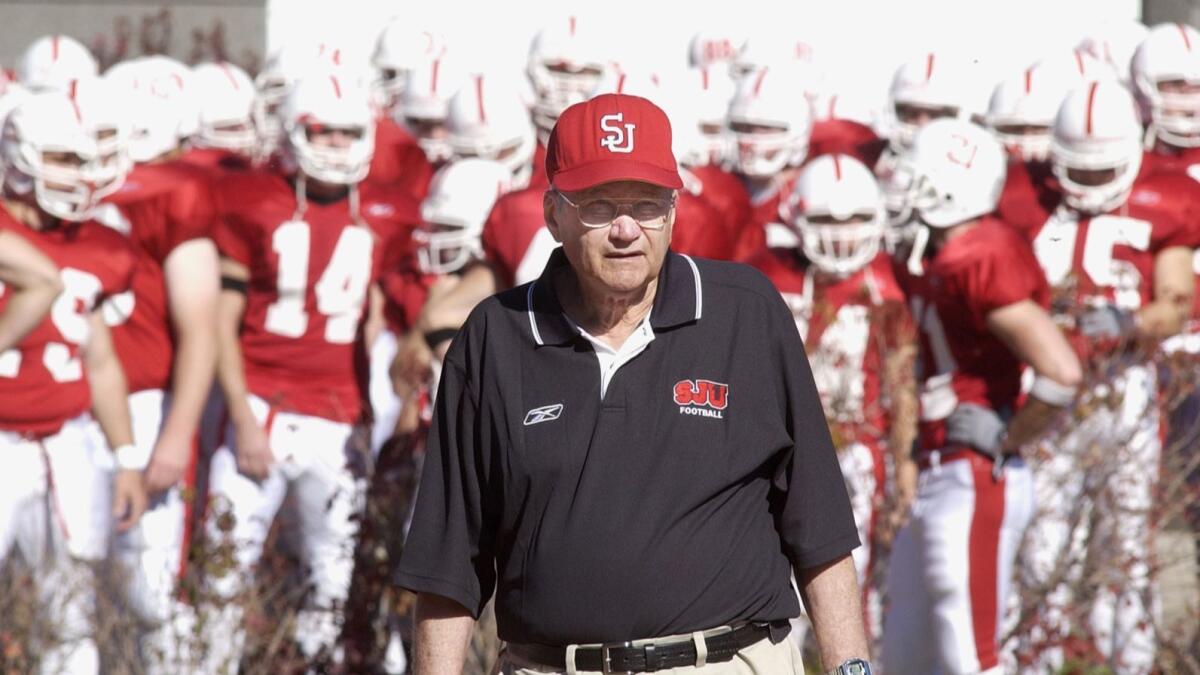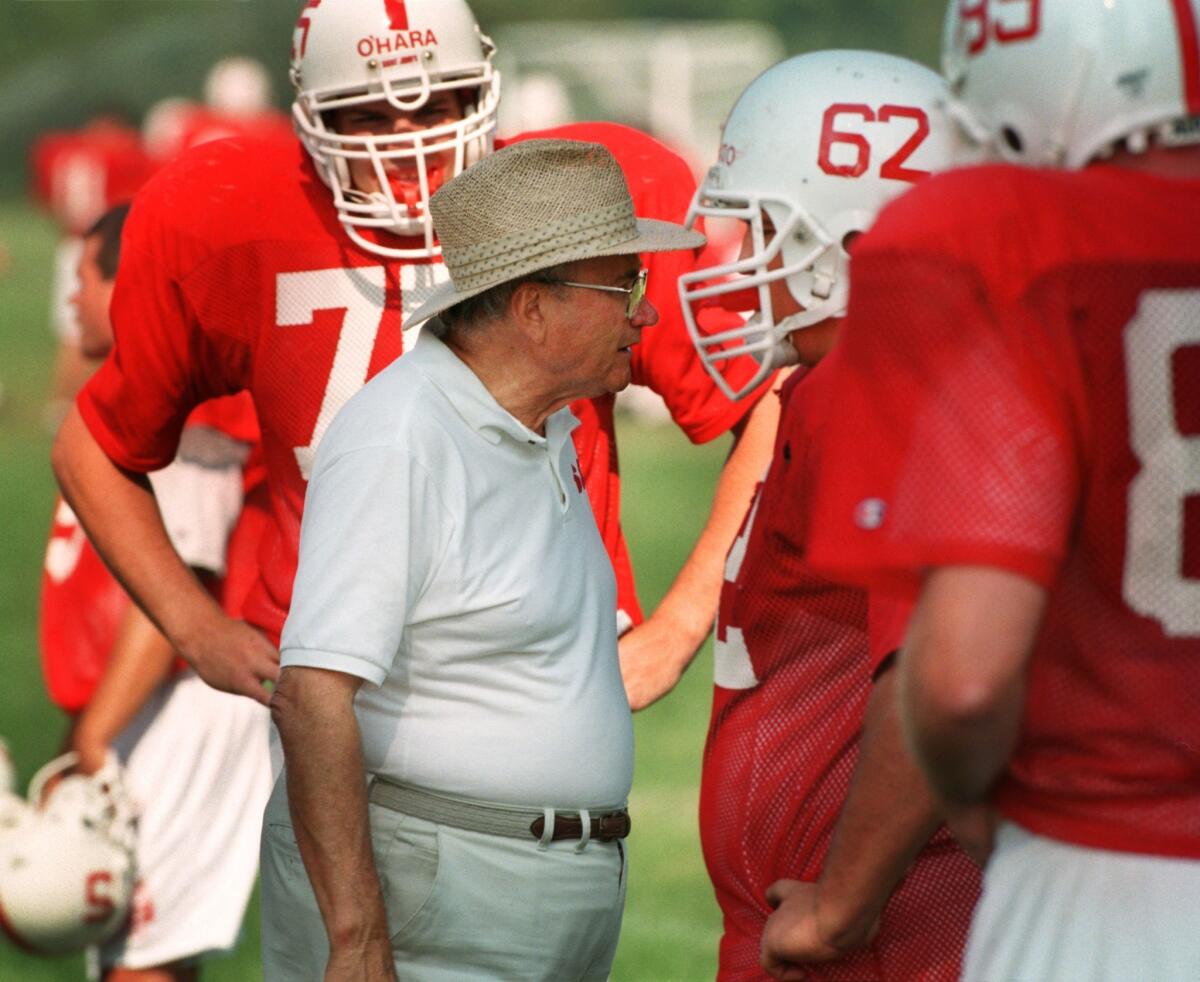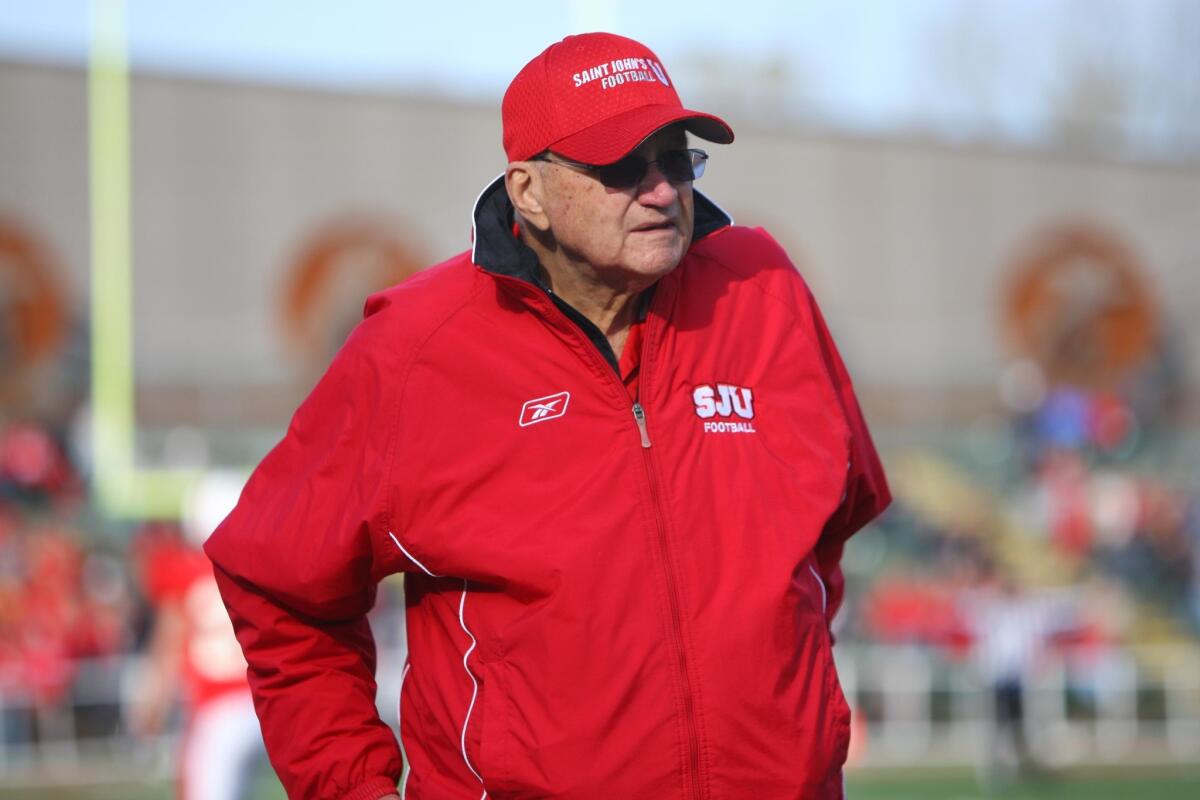John Gagliardi, college football’s winningest coach, was an unlikely visionary

- Share via
On any given Sunday, television viewers watching NFL games may see a commercial called the “Future of Football,” in which Atlanta Falcons coach Dan Quinn intones earnestly about the recent evolution of training camp and tackling techniques.
“Health and safety,” the coach concludes, “is a part of everything we do.” If this is true, good on the NFL, which finds itself merely 60 or so years behind an unlikely pioneer named John Gagliardi, who died Sunday at the age of 91.
Gagliardi won more games — 489 — than any other coach in college football history. He was a head coach for 64 seasons, 60 of them at St. John’s in Collegeville, Minn. There, behind a stand of druid-like evergreens just off Interstate 94, he conducted a brilliant football experiment that won the Johnnies four national championships, and showed football how it might save itself.
He was shrewd, complex, and very funny — a frustrated comedian who served as a kind of Lou Holtz for Division III. He was a perfectionist and a devout family man. He was also a visionary.
Here was his conundrum: Even when he pulled his starters at halftime, the reserves often kept on scoring — though sometimes not enough to suit the Benedictine monks who ran the college. Following St. John’s 67-19 drubbing of St. Olaf in 1991, Gagliardi was admonished by several of the older monks. Reminding him of the Oles’ 80-0 rout of the Johnnies in 1930, they complained that he hadn’t run the score up enough.
Hired in 1953, Gagliardi succeeded Johnny “Blood” McNally. “Why are you leaving?” the bespectacled newcomer asked the future charter member of the Pro Football Hall of Fame. “These Benedictines,” McNally grumbled, “they want to win, but they won’t give you a nickel.”
Gagliardi was a mere 26 years old at the time, but seasoned. He’d already been a head coach for four seasons, at Carroll College in Helena, Mont. But it was his first taste of coaching that shaped a philosophy that can fairly be described as revolutionary.
In 1943, before Gagliardi’s senior year at Trinidad (Colo.) Catholic High, his football coach went off to World War II. The principal, Father Sebastiani, thought it best to cancel the season.
How about if we run practice ourselves, Gagliardi pleaded with the priest, who gave his consent. Left to their own devices, Gagliardi and his teammates learned that many of the sport’s longest-held practices and traditions — moronic calisthenics, bludgeoning each other five days a week in practice, depriving themselves of water — were impediments, rather than keys, to success.

The Tigers of Trinidad Catholic spent most of their time — get this — practicing the plays, until they got them just right. They won the league title. In ways that would be obscured for decades, the game of football also won.
Thus were sown the seeds for Gagliardi’s “Winning With No’s” program: no whistles, no playbooks, no coaching towers or blocking sleds, no use of words like “hit” or “kill,” and no cuts. (In 1999, the year I embedded with the Johnnies to write a book called ‘The Sweet Season,’ there were 159 players out for the team.)
In what may have been his most progressive move, Gagliardi also forbade tackling and cut-blocking during practice. He despised losing players to injury. Noting that most teams make their quarterbacks off limits during practice, he would argue, “What about these other guys? They’ve got mothers, too.”
The List of No’s included “No calisthenics,” which actually meant no traditional calisthenics. To amuse themselves, and gently mock the mindless, calcified rituals still observed by many squads, the Johnnies have long participated in a parody of calisthenics, which includes the “The Beautiful Day Drill” (players lie on their backs, gazing up at the foliage and central Minnesota sky while remarking to each other, “Beautiful day, isn’t it?”). The “cals” may have reached an apotheosis during the 2003 season — St. John’s most recent national championship — when they included “three Mary Catherine Gallagher Superstar Lunges (wavelike fashion, left to right)” and “one Deep Breath with Bruce Lee Exhale.”
What price did the Johnnies pay for their unorthodox, irreverent approach to such a serious game? Following a few middling seasons, during which Gagliardi fine-tuned his philosophy, they went 9-0 in 1962 but weren’t invited to the NAIA playoffs, which in those days determined the small-college national championship. A year later, they did make it to the NAIA championship game, only to come up against a Prairie View A&M team led by quarterback Jim Kearney, who would play nine seasons for the Kansas City Chiefs.
Kearney’s go-to receiver was a rangy junior named Otis Taylor, a future All-Pro with the Chiefs. On defense, Prairie View featured sophomore Kenny Houston, a 1986 inductee into the Pro Football Hall of Fame. Eight Panthers from that team were drafted by the AFL or NFL. “Vince Lombardi would end up double-teaming Taylor,” Gagliardi said. "And we're out there covering him with Bernie Beckman."
But here was the secret: Beckman, like many of the Johnnies Gagliardi lured to Collegeville through the decades, could ball. Guys who might have starred in Division II, and in rarer cases thrived with the big dogs in DI, chose to have fun, and contend for national titles, playing for Gagliardi.
None of which improved the outlook that afternoon against Prairie View. Houston blocked St. John’s first punt, and the Panthers scored on their first play from scrimmage. The Johnnies clawed back, trailing 14-13 at halftime, then took the lead in the second half, on a play-action touchdown pass to Hardy Reyerson, who’d turned aside DI scholarship offers because he wanted to play for Gagliardi. At the end of a soggy, foggy December day at Sacramento’s Camellia Bowl, in one of the biggest football upsets you’ve never heard of, St. John’s won its first national title, 33-27.

What may have been Gagliardi’s second-biggest upset came 40 years later, when the Johnnies snapped the 55-game winning streak of Mount Union. This feat was accomplished at the Amos Alonzo Stagg Bowl, the DIII national championship — Gagliardi’s fourth.
That win helped ease the pain the Johnnies felt following the 2000 Stagg Bowl, when they lost to the Purple Raiders, 10-7, on a last-second field goal. One of St. John’s defensive stars in that game was Beau LaBore, who now teaches social studies and is coach at Stillwater (Minn.) High. A fortnight before Gagliardi passed away, LaBore was one of many ex-Johnnies who gathered in Collegeville to honor their old coach.
When Gagliardi asked LaBore if the Stillwater Ponies had won their game the previous night, his pupil answered, “Not this time.”
“You know,” Gagliardi consoled, “one thing I noticed when I was coaching: When my players were really good, I tended to be really good.”
They shared a laugh.
The day Gagliardi died, LaBore was taking in some NFL on TV, and saw that “Future of Football” spot — the one in which Falcons coach Quinn talks about all the league is doing “with the players’ interest in mind.”
“So what’s happening,” LaBore concluded, “is that you have one of most competitive, successful businesses in the world adapting to do things the way John had been doing them for decades.”
When the Ivy League moved to eliminate full contact from practice before the 2017 season — following the lead of Dartmouth coach Buddy Teevens, who’d instituted such a policy seven years earlier — it was rightly lauded for its foresight and progressivism. But Teevens and company were merely following a path Gagliardi had been blazing since the middle of the last century.
While saluting his old mentor as a pioneer, LaBore emphasized that “first and foremost, he helped young men become good men.”
“Of course I’m sad,” LaBore added, “and I’ll probably have a lot of emotions at his funeral” in Collegeville on Oct. 14. “But right now what I’m mostly feeling is gratitude for having known him.
“I mean, the man lived to be 91! He was the most successful football coach of all time, and he had a blast doing it. If any of us can do anything half that fruitful and fulfilling, well, we will have led a pretty damned good life.”
sports@latimes.com
Go beyond the scoreboard
Get the latest on L.A.'s teams in the daily Sports Report newsletter.
You may occasionally receive promotional content from the Los Angeles Times.







